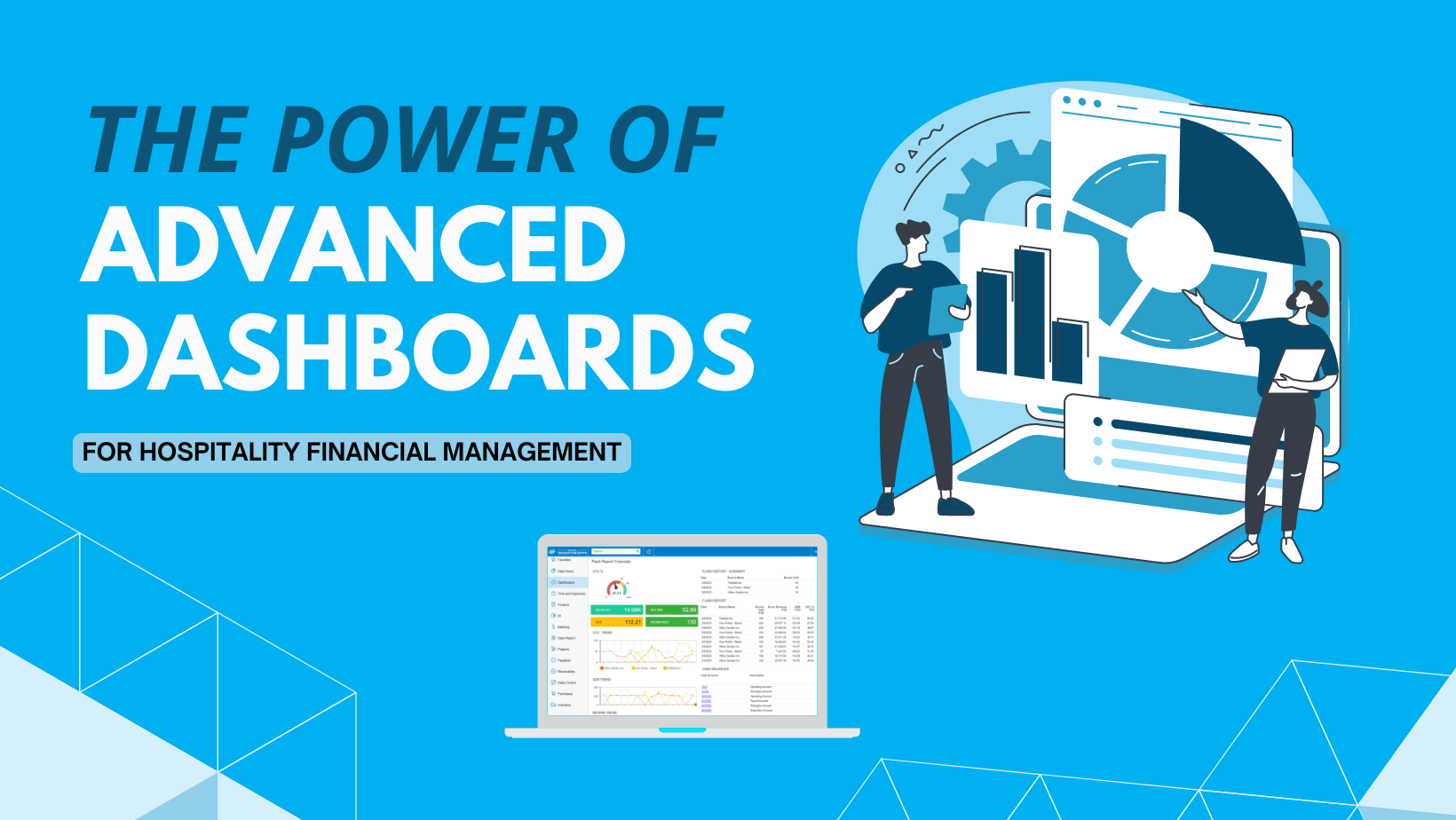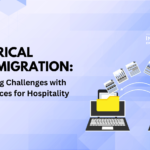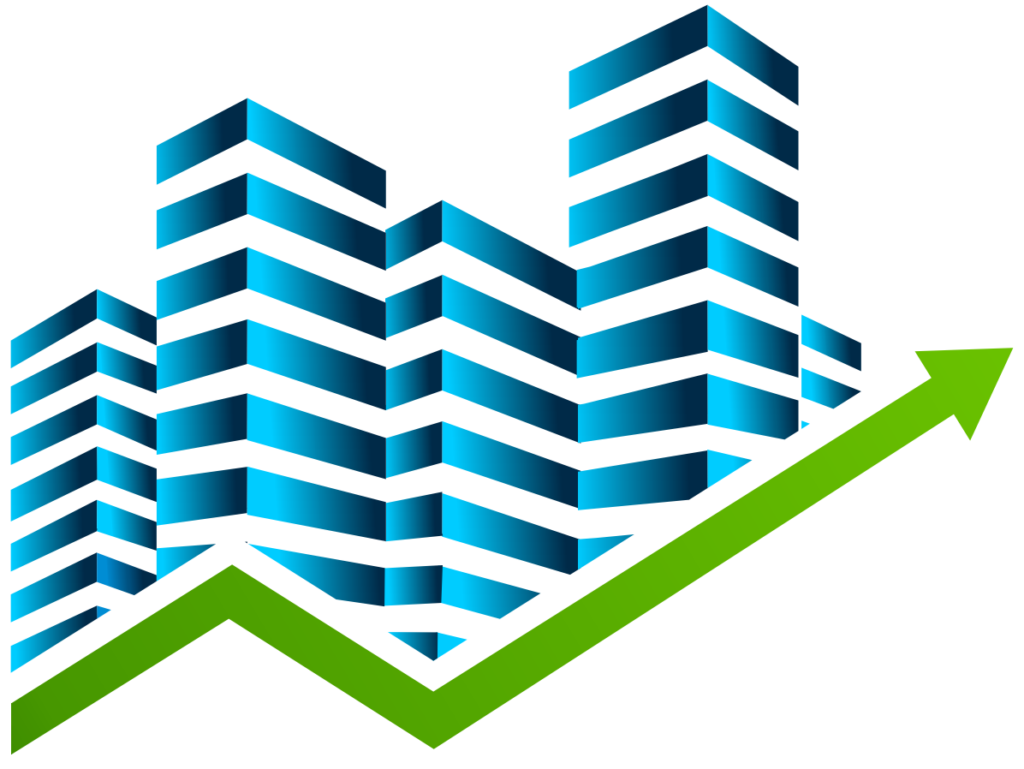“The numbers are… how we keep score in the game of hotel management.” – David Lund, hotel financial coach and author, “The Prosperous Hotelier”
If numbers are how we keep score in hotel management, then hotel teams deserve the best scoreboards possible with which they can track performance against budget and keep their eyes on the prize.
While financial reports will always provide the meat of the data, they can be time consuming to prepare and data-heavy, when what is needed is a quick summary of Key Performance Indicators (KPIs) for daily decision making.
Enter the role of financial management dashboards – scoreboards that help your team see what is happening in the game in real time with both numbers and visualizations, view results from previous periods, and get inputs from other sources, like live bank-balance feeds, to get a full view of performance.
Yet not all hotel accounting dashboards are created equal. While any dashboard is certainly an improvement over none, the real gains come from advanced dashboards that visualize complex data into simple, key takeaways, and provide drill-down capability for deeper insights. Let’s take a look at seven key features of advanced dashboards to help give your team a leg up.
7 Key Features of Advanced Dashboarding
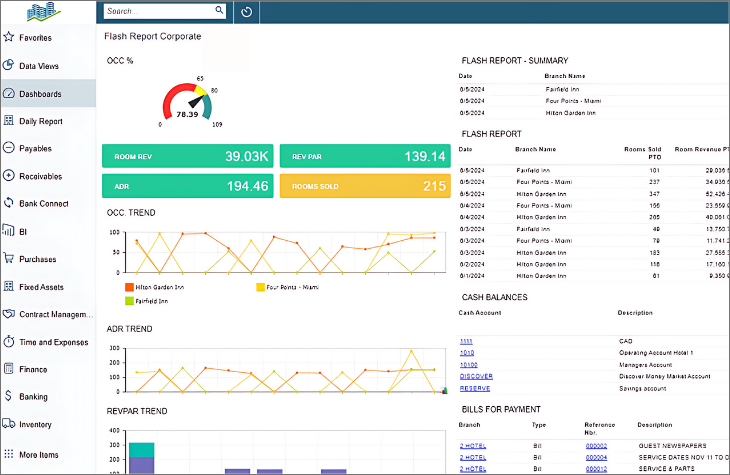
1. An Advanced Dashboard Pulls in Data from Multiple Sources
Having your various data sources streamed into your dashboarding and reporting system is crucial in today’s tough labor environment because it reduces time spent generating many separate reports. With automatic data imports you can quickly view your hotel or portfolio KPIs, or have the more detailed reports emailed to you without having to log into multiple systems to generate and compile the data for analysis.
Data available in your dashboard might come from automatic PMS and POS imports, live Bank Balances streamed in, from modules in your accounting system like AP, and even can include embedded web pages such as Medallia.
2. An Advanced Dashboard is Visual
Rather than just showing the numbers, one of the great benefits of dashboards over reports is that they can simplify the data by visualizing it. For example, Hotel Investor Apps (HIA), has KPI tiles that are color coded in green, yellow, or red based on predefined parameters. All tiles are drill-down ready to get more information and take action. Graphs and charts also make it easy to identify trends over time or make performance comparisons between hotels.
Buck Paolino, CEO of hotel accounting firm Platform Business Advisors, notes about HIA dashboards,
“We know for our clients, a big thing is being able to just see a quick snapshot dashboard. They want to see a visual representation of what’s actually happening. The dashboards help explain the story of what’s going on in the financial statements. When you can say, ‘Hey, your ADR is down $10 from where you expect it to be.’ That might not sound like much but over 30 days that adds up a lot, especially if that’s their baseline – and so in the dashboards it’s either a color code or there are visual representations to convey that.”
3. An Advanced Dashboard is Interactive
Rather than just showing the top-line number, advanced dashboards give users the ability to drill down into the numbers to find the source data. For example, in HIA you can click any KPI tile, line item, blue link, or data point in a graph and drill down to any transaction, record, or document.
4. An Advanced Dashboard is Customizable
Dashboards are meaningful because they provide the important data relevant to you at a glance. In HIA, our dashboards come with the ability for you to set custom triggers and alarm thresholds, such as with color coding, so you can easily see if your numbers are in line with your expectations.
The dashboards are also fully customizable with Drag and Drop so you can add or subtract widgets to make your ideal dashboard.
5. An Advanced Dashboard is Up-to-Date
One of the main advantages of dashboards over reports is that dashboards automatically refresh with new data as it comes in, so you always have the most current information at your fingertips. These real time updates help you to stay on top of performance without needing to manually pull a report.
6. An Advanced Dashboard is Secure
While financial visibility and accessibility is important, so is security and data privacy, which is why in HIA, dashboards follow the same user role based permissions as the rest of the system. Security can also be further enhanced by adding device based permissions.
And as a born-in-the-cloud ERP, HIA already comes with an advanced system architecture, cloud security measures, encryption, and frequent back-ups.
7. An Advanced Dashboard Has Property and Portfolio Views
Similar to the role-based user security feature, dashboards and access can be set according to role. This means some users will have property-specific, or regional access, while other users can access the property, portfolio, and corporate management company books.
HIA’s advanced property dashboards can include key items like flash reports compared to budget/last year, or forecast; documents to pay; approvals; AR and AP access; and cash balances.
HIA’s corporate view dashboards include portfolio wide metrics and KPIs, as well as corporate flash reports with options for versus budget/last year, or forecast, as well as bank balances, AR and AP, and more.
“At HIA we are dedicated to providing a system that provides the financials more efficiently, and in a way that is accessible and understandable. This is why advanced dashboards are core to HIA, so the key takeaways are available at a glance,” notes Chip Fritsch, COO of Hotel Investor Apps.
Accounting Dashboards vs BI Dashboards
It’s important to note that hotel financial management/accounting dashboards should not be confused with a full business intelligence suite which offers dynamic analysis by allowing you to adjust and layer various parameters on the fly to customize reporting metrics and data visualizations.
HIA’s dashboards for business intelligence can get even more exciting with rich data from more sources and layered data to get deeper performance insights. For example, with financial, operational, and labor data, BI dashboards provide detailed information on key labor statistics like MPOR, CPOR, and wages. For more on HIA’s Business Intelligence click here or read our recent blog on Labor Intelligence.
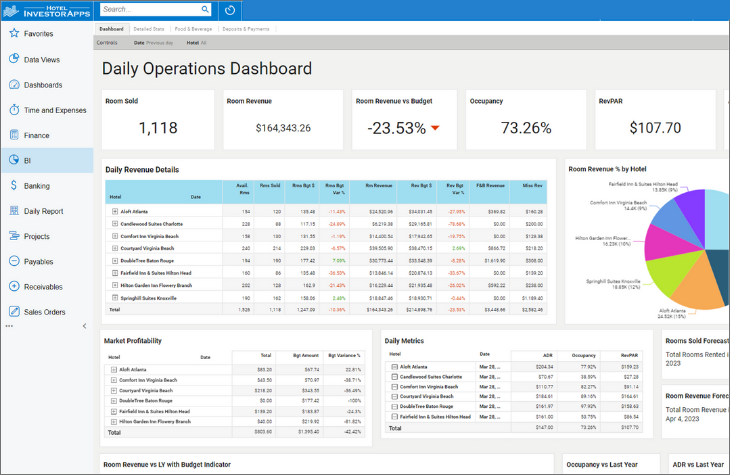
Summary
In hotel finance and operations, keeping the eye on your budgeted goals and performance is key to staying on track and exceeding performance goals.
Dashboards are a key tool to keep your finger on the pulse of performance on a property, regional, portfolio, and corporate level. That said, not all dashboards, or accounting platforms, are built alike, and few, if any, have the advanced capabilities to rival HIA’s dashboards.
Empower your hospitality team with the best financial management tools on the market, and on a platform that is custom built for hospitality.
Request a demo to see HIA in action today!

Director of Marketing at HIA
Elisa Fritsch, Director of Marketing at Hotel Investor Apps (HIA), contributes 15+ years of sales and marketing experience from a wide range of corporate to start-up environments. At HIA, Elisa focuses on marketing strategy, content, and leveraging her hospitality industry knowledge to drive growth.


